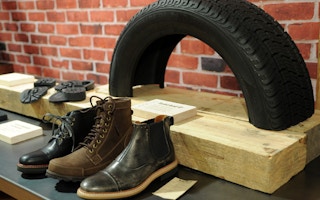Singapore-based tyre distributor Omni United and United States casual outdoor shoe and clothing maker Timberland have launched a new line of tyres whose life cycle is nearly a closed loop - a first in the industry.
To continue reading, subscribe to Eco‑Business.
There's something for everyone. We offer a range of subscription plans.
- Access our stories and receive our Insights Weekly newsletter with the free EB Member plan.
- Unlock unlimited access to our content and archive with EB Circle.
- Publish your content with EB Premium.
Branded ‘Timberland Tires’, these tyres for cars, trucks and vans will be made in the United States from domestic and imported materials, and will be sold from April next year. A closed loop is any system in which waste - used tyres in this case - is used again in making another product.
At the end of their lifespan, after 50,000 to 80,000 miles (or about 80,000 to 130,000 kilometres), retailers will set aside the branded tyres to be recycled into crumb rubber, which has a granular, crumb-like form, by US-based Liberty Recycling.
The crumb rubber will then be processed into sheet rubber and used in shoe outsoles by Timberland manufacturers. The first batch of tyres should be ready for recycling in late 2017, the firms estimate.
The two companies announced their collaboration at the Specialty Equipment Market Association show, a major automotive specialty-products trade show, in Las Vegas earlier this month.
“Given the strength of the Timberland brand, and our target consumer’s appreciation for sustainability, we see a huge opportunity to change the way people choose their tyres,” said G.S. Sareen, president and chief executive of 11-year-old Singapore firm Omni, whose tyres are distributed in more than 80 countries around the world.
Last year, Omni’s line of Radar tyres was the industry’s first to be declared carbon-neutral. This was achieved through the purchase of carbon credits from wind and solar energy projects to offset the emissions from their manufacturing and distribution.
The idea for Timberland Tires was born three years ago, when both companies began collaborating on sustainability solutions for their industries, said Sareen.
“
With Timberland Tires, we have the opportunity to find a consistent source of recycled tyre rubber that also meets our stringent standards… This helps keep more tyres out of landfills, and use less virgin rubber in our footwear.
Stewart Whitney, Timberland president
Tyre makers and footwear manufacturers are among the largest users of the world’s virgin rubber. In 2012, global virgin rubber production was 11.4 million tonnes, according to latest available figures from the United Nations’ Food and Agriculture Organisation. The rubber is mainly produced in Southeast Asian countries such as Thailand, Indonesia, Malaysia and Vietnam.
At the end of a tyre’s lifespan, it often goes straight to landfill if it is not used for tyre-derived fuel (shredded tyres burned for energy) or in rubberised asphalt, a pavement material, or other products.
In the United States alone, an estimated two to three billion scrap tyres have been stockpiled in scrapyards or unregulated dumps over the years; if not properly disposed of, they can be breeding-grounds for pests.
So why a branded line of tyres? Timberland president Stewart Whitney explained that the tyres, specially formulated and segregated at the end of their automotive life, would ensure a more consistent quality of shoe materials.
Many of Timberland’s shoe outsoles are made with what it calls Green Rubber, made from 42 percent recycled post-industrial latex. While the firm used recycled tyres initially, it could not get a steady supply of used tyres that met its standards, Whitney said.
“With Timberland Tires, we have the opportunity to find a consistent source of recycled tyre rubber that also meets our stringent standards for quality, performance and environmental compliance. This helps keep more tyres out of landfills, and use less virgin rubber in our footwear.”
The Timberland Tires will be marketed first in the US to prove that the complicated logistics of segregating and taking back tyres works well and to iron out the business model, said John Soule, vice-president of global marketing and licensed brands for Omni.
“The plan is to go into Asia-Pacific in the coming years, but we want to do it very thoughtfully and correctly, and have all the elements of the take-back strategy in place first,” he said.
While there are no estimates yet for the carbon footprint of the tyres, shoes, and overall process, Timberland’s Whitney said once the items are in production, the life-cycle analysis of the entire process will be measured and published in Timberland’s sustainability reports.
The ultimate end goal, Whitney said, is “cradle-to-cradle” footwear in which materials are reclaimed and reused at the end of a product’s life to cut waste. “We’re certainly not there yet, but that goal is a daily reminder of our quest to be the largest, most sustainable outdoor lifestyle brand,” he added.










